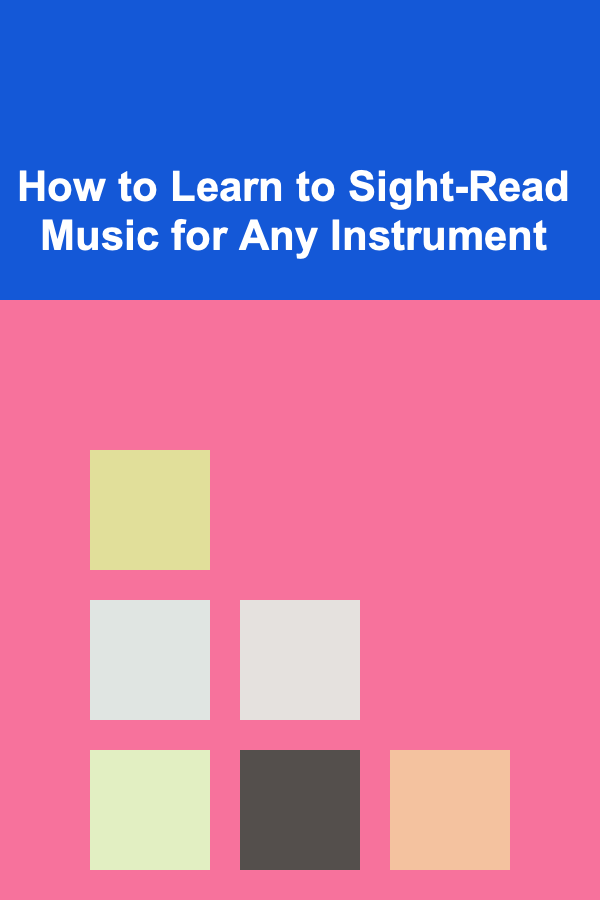
How to Learn to Sight-Read Music for Any Instrument
ebook include PDF & Audio bundle (Micro Guide)
$12.99$5.99
Limited Time Offer! Order within the next:

Sight-reading music is one of the most valuable skills for musicians, whether they are beginners or seasoned professionals. The ability to sight-read allows musicians to pick up a piece of music and perform it immediately, without having to memorize it beforehand. This skill is essential for playing in ensembles, reading new compositions, or simply enjoying the challenge of playing a new piece. But how exactly does one go about learning to sight-read music for any instrument? In this article, we will explore the steps, strategies, and techniques that will help you become proficient at sight-reading.
What is Sight-Reading?
Sight-reading is the ability to read and perform a piece of music at first sight, without prior preparation or memorization. The key to sight-reading is not to focus too much on individual notes, but rather on recognizing patterns, rhythms, and key signatures as quickly as possible. It is a combination of reading the musical notation, understanding musical language, and translating it into sound on your instrument.
Sight-reading is especially important for musicians who perform in groups or orchestras, as they must often play pieces they have never seen before. It's also a crucial skill for composers, arrangers, and music educators. For instrumentalists, sight-reading goes beyond reading music for the sake of it; it helps develop a deeper understanding of musical structure and improves improvisation skills.
Why is Sight-Reading Important?
- Enhances Musicianship: Being able to sight-read improves your overall musicianship, making you a more versatile musician. It helps you develop an understanding of musical syntax, and this can translate into more confident performances.
- Saves Time: If you can sight-read well, you can immediately begin practicing a piece of music without needing to spend hours memorizing it. This is particularly helpful when you need to learn multiple pieces quickly, as is often the case in orchestras or large ensembles.
- Boosts Confidence: Sight-reading gives musicians the confidence to tackle new music, which can prevent anxiety when encountering unfamiliar pieces. It reduces the pressure of having to memorize long passages of music and instead focuses on interpreting the music as it is presented.
- Improves Musical Ear: The more you practice sight-reading, the more you will develop your ear for music. You'll become adept at hearing intervals, recognizing chord progressions, and identifying the structure of a piece in real time.
Steps to Learn Sight-Reading for Any Instrument
While sight-reading can seem like an intimidating skill to master, it is achievable with consistent practice and focus. Below are the steps to guide you through the process of learning to sight-read music for any instrument.
Step 1: Learn the Basics of Music Notation
Before diving into sight-reading, it's important to have a solid understanding of music notation. This includes:
- Notes and their Values: Understand the different types of notes (whole, half, quarter, eighth, etc.) and their corresponding durations.
- Clefs: Be familiar with treble, bass, alto, and other clefs. The clef determines the pitch of the notes you read.
- Key Signatures: Understand how key signatures work and how they affect the notes you play. The key signature tells you which notes are sharp or flat for the entire piece.
- Time Signatures: Time signatures tell you how many beats are in each measure, and which type of note gets one beat. This affects how you count and group the notes.
- Rhythm and Timing: Learn how to recognize different rhythms and note groupings. This is critical for maintaining steady timing when sight-reading.
Having a good grasp of these fundamentals will allow you to read music more efficiently and intuitively, which is essential for sight-reading.
Step 2: Start with Simple Pieces
If you're new to sight-reading, it's important to start with simple pieces that are within your current skill level. Choose music with basic rhythms and a limited range of notes. For beginners, simple folk songs, children's tunes, or beginner piano pieces are great places to start. Over time, you can progressively tackle more difficult compositions.
When you first begin sight-reading, it's important not to worry about playing perfectly. Focus instead on recognizing patterns and rhythms, and aim to play through the piece as smoothly as possible.
Step 3: Focus on Rhythmic Accuracy
Rhythm is one of the most important aspects of sight-reading. Even if you can't play every note perfectly, maintaining accurate rhythm is key to making the piece sound musical. Practice clapping or tapping rhythms before playing the actual piece to internalize the timing and patterns.
Start by focusing on simple rhythmic patterns, like quarter notes, eighth notes, and rests. Gradually, as you become more comfortable, challenge yourself with more complex time signatures, syncopation, and polyrhythms.
Step 4: Train Your Eyes to Read Ahead
One of the most important skills in sight-reading is the ability to read ahead while playing. This means that while you are playing a note or phrase, your eyes should already be scanning ahead to the next measure or section. This will prevent you from getting stuck or hesitating when you encounter a difficult passage.
To improve this skill, practice reading one measure ahead while playing. As you become more proficient, you can try to read two or more measures ahead. This is a gradual process, and it will take time to build up the ability to read ahead naturally.
Step 5: Break the Piece into Sections
Instead of trying to sight-read an entire piece at once, break it into smaller sections. Focus on sight-reading one phrase, section, or line at a time. This will help you build confidence and ensure that you don't become overwhelmed by the piece as a whole.
Once you feel comfortable sight-reading short sections, gradually increase the length of the passages you work on. This incremental approach will help you build stamina and reduce mistakes.
Step 6: Use a Metronome
A metronome is an essential tool for any musician, especially when it comes to sight-reading. It helps you maintain a steady tempo, even when you are reading unfamiliar music. Start by setting the metronome at a slower tempo that allows you to play comfortably, then gradually increase the speed as you become more confident.
If you encounter a tricky section, slow it down to a manageable speed and practice it several times before returning to the original tempo. This will help you play with greater accuracy while keeping your sense of timing intact.
Step 7: Practice Regularly
Sight-reading, like any musical skill, requires consistent practice. The more you practice, the better you will become at recognizing patterns and reading music quickly. Try to sight-read at least 10-15 minutes a day, even if it's just a short passage. Over time, your sight-reading ability will improve, and you'll find that you can tackle more complex pieces with ease.
Step 8: Challenge Yourself
As you improve, start challenging yourself with more difficult pieces. This will push you to expand your skills and develop faster sight-reading abilities. Choose music that is just slightly above your current level, so you are forced to learn new techniques and concepts. You can also experiment with different genres of music to diversify your sight-reading experience.
Step 9: Analyze Before You Play
Before you begin sight-reading a piece, take a few seconds to analyze the music. Look for key signatures, time signatures, changes in dynamics, tempo markings, and other performance instructions. This will help you anticipate what is coming and give you a mental roadmap of the piece. You'll be less likely to stumble upon a surprise if you've already mentally prepared for it.
Step 10: Keep Track of Progress
Finally, keep track of your sight-reading progress. Take note of pieces you've mastered, your speed, and the types of challenges you've faced. This will help you identify areas that need more practice and allow you to focus on specific skills.
Sight-Reading Tips for Specific Instruments
Piano
Piano sight-reading can be particularly challenging because it involves reading both treble and bass clefs simultaneously. The best approach for piano sight-reading is to practice reading each clef independently, then combine them slowly. Additionally, try to maintain a relaxed hand position to avoid tension and strain.
String Instruments (Violin, Cello, etc.)
For string players, sight-reading can be difficult because of the need to maintain proper finger placement while reading. Focus on recognizing patterns of intervals and bowing techniques. Try to practice scales and arpeggios in different keys to improve your fingerboard knowledge.
Wind and Brass Instruments
Wind and brass players should focus on reading pitches accurately and maintaining a steady breath support. Practice sight-reading in different keys and focusing on reading the rhythmic patterns correctly. Brass players should also focus on embouchure consistency to maintain proper tone quality when sight-reading.
Conclusion
Learning to sight-read music for any instrument is a valuable skill that takes time and practice to develop. By following the steps outlined in this article, you can improve your sight-reading ability and become a more confident and capable musician. Remember that the key to success is consistent practice, patience, and a willingness to challenge yourself with increasingly difficult music. As you improve your sight-reading skills, you'll find that it enhances your overall musicianship and opens up new opportunities for musical exploration.
Reading More From Our Other Websites
- [Organization Tip 101] How to Organize Your Workspace for Enhanced Focus
- [Organization Tip 101] Common Mistakes to Avoid When Using Kitchen Cabinet Refacing Kits
- [Home Soundproofing 101] How to Use Mass-Loaded Vinyl (MLV) for Superior Soundproofing
- [Organization Tip 101] How to Designate a Craft Zone in Your Home
- [Needle Felting Tip 101] How to Produce Needle‑Felted Light Fixtures that Diffuse Ambient Lighting Softly
- [Organization Tip 101] How to Create a Monthly Budget That Works for You
- [Home Party Planning 101] How to Plan a Home Party for Every Occasion: Birthdays, Anniversaries, and More
- [Home Rental Property 101] How to Secure Insurance for Your Rental Property
- [Organization Tip 101] How to Use Magnetic Strips for Small Tool Storage
- [Home Budget 101] How to Set Up an Emergency Fund for Home Expenses

How to Keep Your Home Safe While Traveling
Read More
How to Master Frugal Living with Kids
Read More
How to Prepare Your Finances for Buying a Car
Read More
How to Set Up a Checklist for Implementing Two-Factor Authentication (2FA)
Read More
How to Use Floor Lamps to Brighten Dark Corners of Your Home
Read More
How to Create a Meeting To-Do List for Remote Teams
Read MoreOther Products

How to Keep Your Home Safe While Traveling
Read More
How to Master Frugal Living with Kids
Read More
How to Prepare Your Finances for Buying a Car
Read More
How to Set Up a Checklist for Implementing Two-Factor Authentication (2FA)
Read More
How to Use Floor Lamps to Brighten Dark Corners of Your Home
Read More